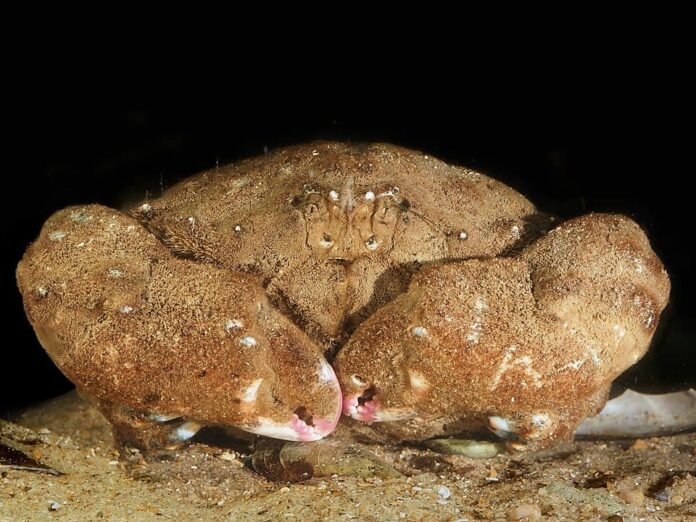I have written quite a few articles about poisonous animals but never about poisonous crabs. Recently, I have seen food poisoning cases after crab consumption too often on social media. I did not know that not all crabs are safe to eat since I am not a fan of crabs myself. Toxic crabs do exist, and a majority come from the Xanthidae family; the biggest crab family in the world. You will find 11 poisonous crab species on the list, and make sure to keep them away from your kitchen.
1Devil Crab
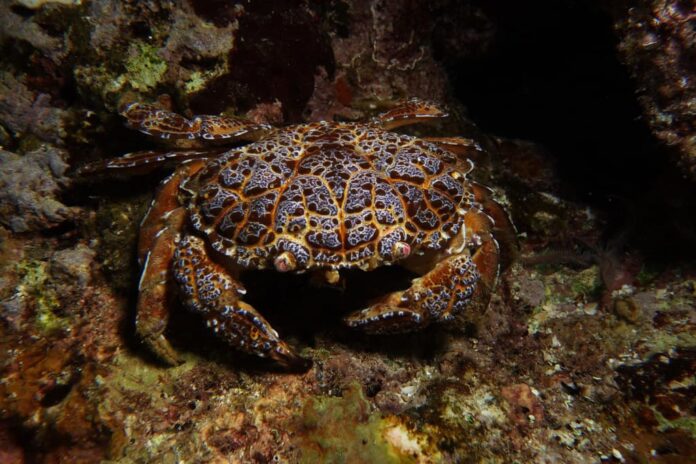
Scientific Name: Zosimus Aeneus
The devil crab also goes by many other nicknames such as devil reef crab and toxic reef crab. It has distinctive patterns of brownish blotches on its carapace, claws, and legs that indicate its toxicity. This poisonous crab species is lethal due to the neurotoxins tetrodotoxin and saxitoxin in its flesh and shell. Toxic reef crabs are so toxic they can kill within a few hours of consumption, even with a small amount. They are also the most poisonous crabs in the Philippines and Timor-Leste as well.
Devil crabs are common in the Indo-Pacific from East Africa to Hawaii, and as far as Australia and Japan. People tend to easily find devil crabs because they live on coral reefs so catching one is not difficult. It is also possible for them to get caught with edible crabs so it is important to differentiate the non-poisonous and poisonous crabs. Next time you see something similar, make sure to check because bright colors and weird patterns scream lethal to eat.
Do You Know…
It is reported that Pacific Islanders use these crabs as a means of suicide.
2Emerald Crab
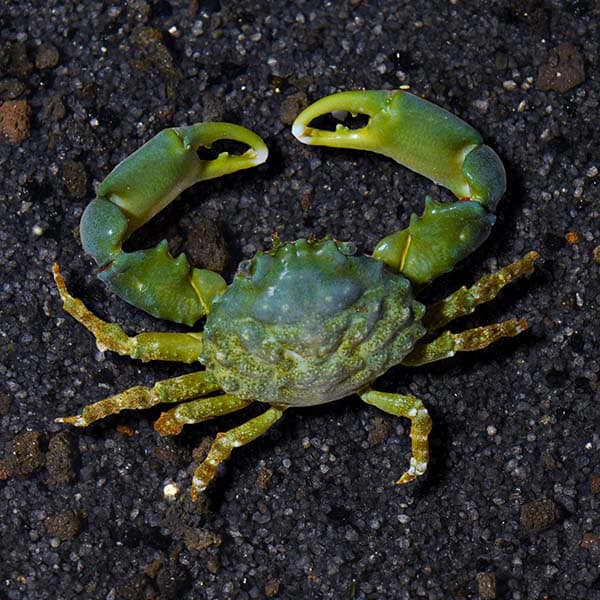
Scientific Name: Mithraculus Sculptus
You can tell an emerald crab by its flat shiny green body and hairy legs that are not common in crabs. The deep green hue on their bodies gives them their name, and they are quite nice to the eyes. An emerald crab is long instead of wide, and it has a flat carapace with a rocky texture. Its hair legs are thin and long while the spoon-shaped claws are large and smooth. Their diet consists of coral algae, poisonous snails, and some crustacean like the yeti crabs.
These poisonous crabs are native to the reefs of the Caribbean where they hide in caves or rubbles during the day. While being lethal to consume, many home aquarium enthusiasts like having them because of their diet. Emerald crabs are scavengers that love feeding on nuisance algae and uneaten meaty foods. So they also eat bubble algae and help clean the tank to keep home aquarium clean as well. The information that you find about them online is more about their aquarium reputation rather than their toxicity.
3Fiddler Crab
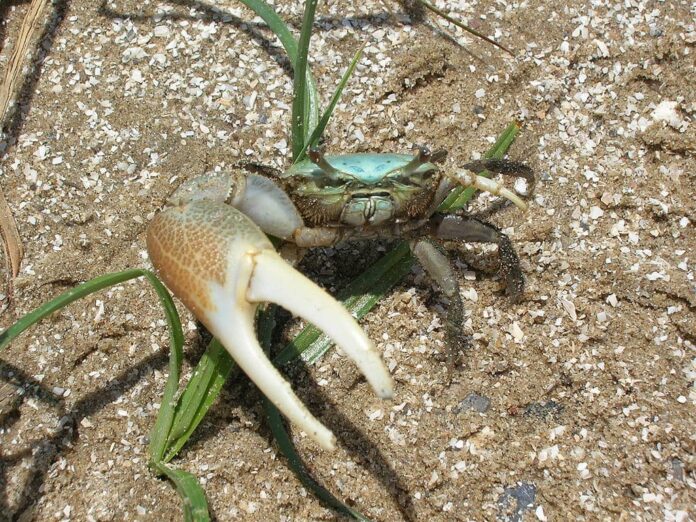
Scientific Name: Uca Longisignalis
Gulf mud fiddler crabs or fiddle crabs in short are one of the poisonous crab species. A fiddler crab has 4 pairs of walking legs and a pair of claws. Males have one claw that is way bigger than the other that they use to attract females. It has a dull gray body that is more green-blue on the anterior of the carapace and long thin eyestalks. The most interesting part is that their colors are darker during the day while getting lighter at night.
They live in coastal marsh regions of the northern Gulf of Mexico, from Western Central Florida to Texas. Within their range, they create cylindrical burrows in marshy areas and sand or mud flats. When the tide goes out, they feed on algae and detritus along the shoreline and in the sand. At the same time, they also eat non-insect arthropods and scavenge every now and then as well.
The thing is that fiddler crabs feed on dead insects and plants that may contain bacteria and parasites. That simply means they contain a toxin called Domoic Acid that can lead to amnesic poisoning. While some poisonous crabs are extremely toxic even after cooking, fiddler crabs are not too serious. Just make sure to prepare and cook them properly when they are fresh before eating them. On the good side, fiddler crabs are highly nutritious with a delicious taste as long as they are safely prepared.
4Floral Egg Crab
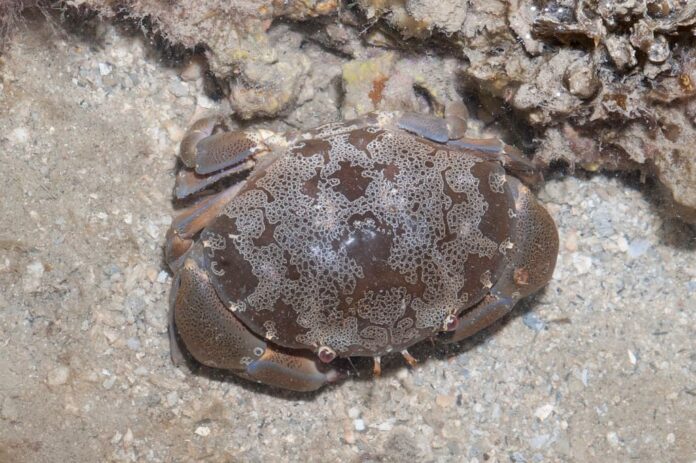
Scientific Name: Atergatis Floridus
Floral egg crabs have many other names such as green egg crabs, pancake crabs, and shawl crabs. A floral egg crab has an oval shell that is narrow with a smooth surface and soft margins. Meanwhile, the carapace is greenish or greenish-blue-brown with white or yellow patterns that resemble a shawl. As you can see, it has large spoon-shaped pincers with black tips.
This crab species occurs in the Eastern Indian Ocean including Southeast Asia all the way to Australia and the Western Pacific. They like to inhabit the neritic zone where they live in coral and rubble. Floral egg crabs are slow-moving and secretive, and they are more active at night. They feed on algae and plants but they also eat fish sometimes.
Not different from the devil crabs, floral egg crabs are so lethal their meat remains toxic even after being cooked. The flesh of this crab species is as toxic as the pufferfish which is extremely dangerous to consume. Some of the symptoms of the poisoning are blurry vision, breathing difficulty, chest tightness, dizziness, extreme muscle paralysis, and headache. Diarrhea, drooling, speaking and swallowing difficulties, stomachache, thirstiness, and vomiting are also possible before unconsciousness and death.
5Marbled Stone Crab
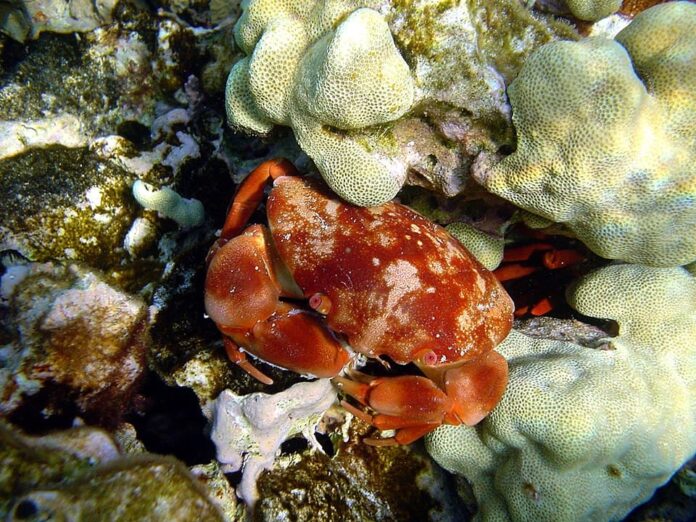
Scientific Name: Carpilius Convexus
The marbled stone crabs has several more nicknames including convex (reef) crab, coral crab, round crab, and variable reef crab. This crab can grow to about 25 centimeters with 4 walking legs and a pair of claws at the front. Marbled stone crabs have a wide distribution in the Indo-Pacific from Japan to Eastern Africa and Easter Island. During the daytime, these crabs shelter in crevices or under the stone and come out to forage for food at night. They usually forage along seashores and over rocky outcrops for mollusks.
Marbled stone crabs are very poisonous because they feed on poisonous mollusks. Divers who don’t know about them pick them for the aquarium trade and occasionally for food. To what extent of how poisonous they are? We don’t know yet but make sure to avoid eating them.
6Montagu’s Crab
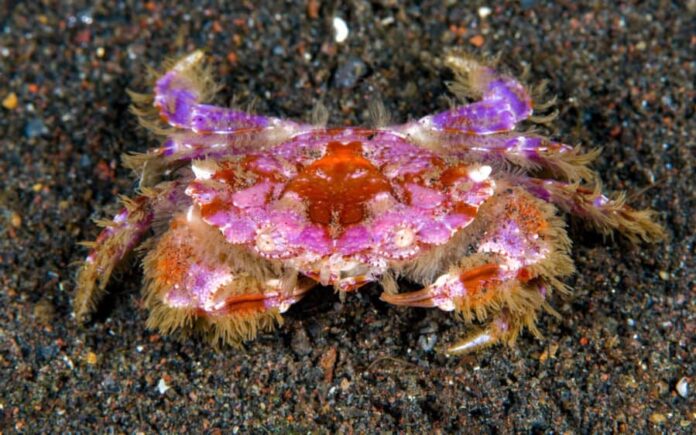
Scientific Name: Lophozozymus Incisus
The Montagu’s crab or furrowed crab is a beautiful crab species with a unique appearance. It has a bright pink and purple carapace that is covered in strange golden hairs. This is just enough to warn any predator that this crab is dangerous to eat so avoid them. The claws of this crab are large and robust, and they are equal in size.
This poisonous crab species is widely distributed in hot waters around the world including Asia, Europe, and Oceania. These crabs live under stones on sandy and stony beaches, usually below the intertidal zone around 40 meters deep. As nocturnal omnivores, they feed on various algae but they also scavenge at times. The Montagu’s crabs are very lethal so cooking them does not remove the toxin at all.
7Mosaic Crab
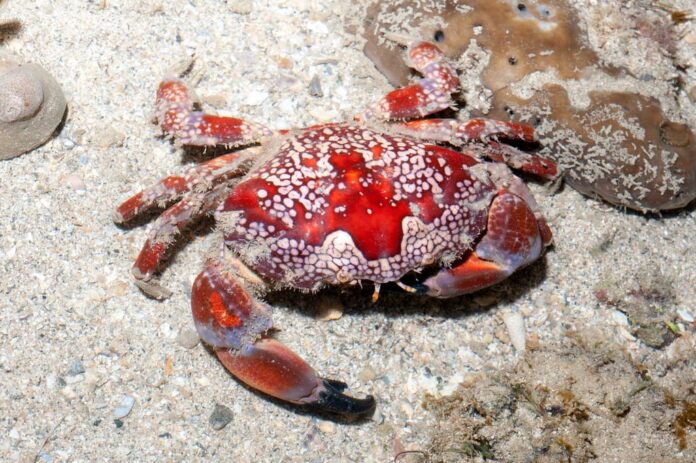
Scientific Name: Lophozozymus Pictor
The mosaic crab or mosaic reef crab is one of the poisonous crabs from the Xanthidae family. It has an elongated fan-shaped body that is red in color with unmistakable mosaic patterns and white spots. Along with that, it has black tips in its pincers that try to tell you that this species is poisonous. It is possible that their toxicity comes from the toxic sea cucumbers that they feed on. That is because the toxins are from their hepatopancreas and gut, suggesting their diet causes them to the toxic.
8Red Egg Crab
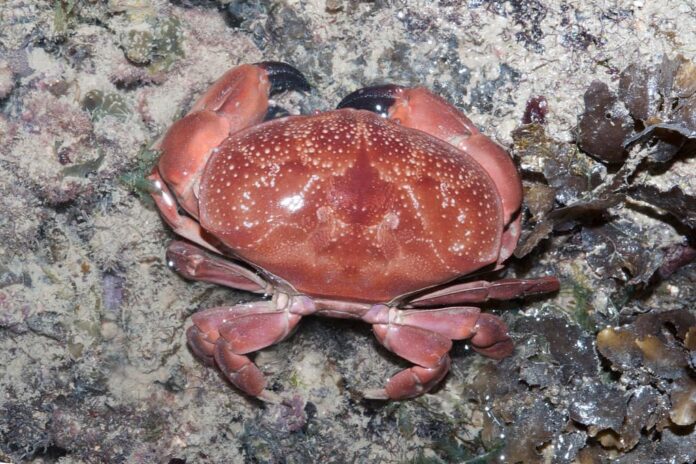
Scientific Name: Atergatis Integerrimus
You are looking at another colorful crab whose meat is so toxic cannot be destroyed by cooking. It has an oval carapace with smooth edges around it that grows from 8 to 10 centimeters. This carapace is usually bright red, reddish-brown, or orange-ish with white spots all over it. The pincers of this crab are about equal in size, and they are spoon-shaped with black tips. Red egg crabs are one of the poisonous crab species but there are no death cases recorded yet.
9Ridged Swimming Crab
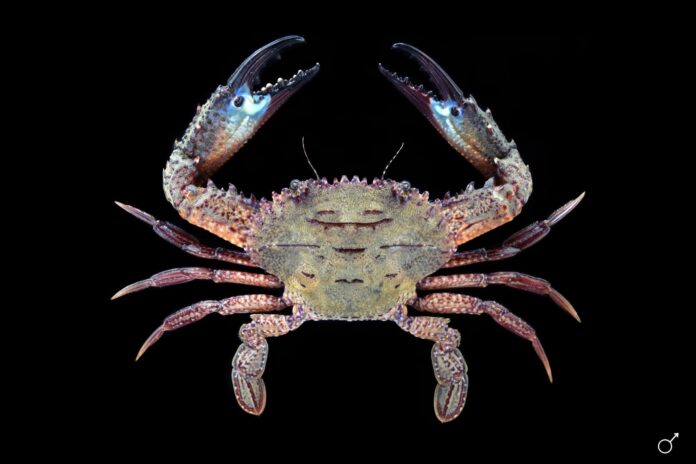
Scientific Name: Charybdis Natator
People also call them rock crabs or wrinkled swimming crabs, ridged swimming crabs got their name from the ridges on their backs. These crabs are very easy to recognize due to the ridges on the top of their carapace. Ridged swimming crabs have a light orange shell after shedding that becomes light brown as time goes by. They have large pincers with a bit of blue on the base of the claws. Rock crabs are poisonous, but we don’t know the level of toxicity that they contain.
Ridged swimming crabs are found in South Africa, the Red Sea, and Australia. They usually hang out on mixed sand and rubble areas under more prominent pieces of rubble. These crabs prey on crustaceans, fish, mollusks, and other slow-moving prey. The interesting thing about them is that they are swimming crabs as they have paddles on their last leg pair. These crabs swim to commute from one place to another instead of walking on the sea floor.
10Seven-Eleven Crab
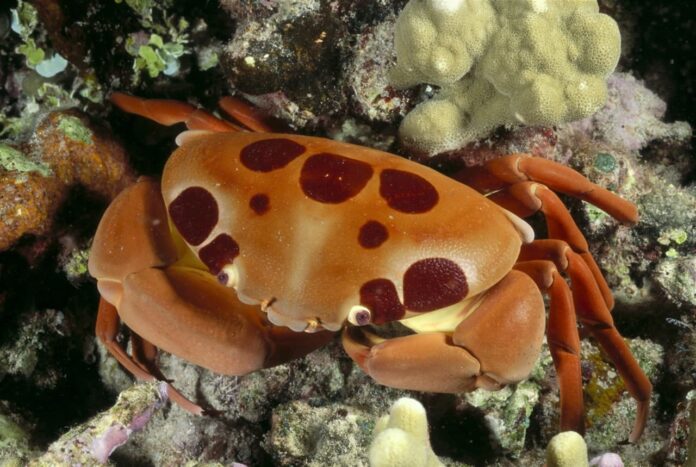
Scientific Name: Carpilius Maculatus
The seven-eleven crabs aka spotted reef crabs are very easy to recognize with large red circular spots on their carapaces. A seven-eleven crab has a convex and smooth surface that is oval in shape. Its basic color is usually cream that is often slightly purple with 9 large brown-red to purple spots. Normally, there are always 3 spots in the middle of the carapace as you can see in the photo here. It actually got its name from 7 spots on the top and another 4 on the bottom of the carapace. Should be 7-4 but oh well, 7-11 is more catchy.
This crab species is found in the Western Pacific from Indonesia to Micronesia. The actual data on their toxicity is unknown but it is believed that they are toxic because of their diet. Spotted reef crabs feed on poisonous snails that may cause them to be also poisonous. However, there is no confirmation on this claim yet.
11Sleepy Sponge Crab
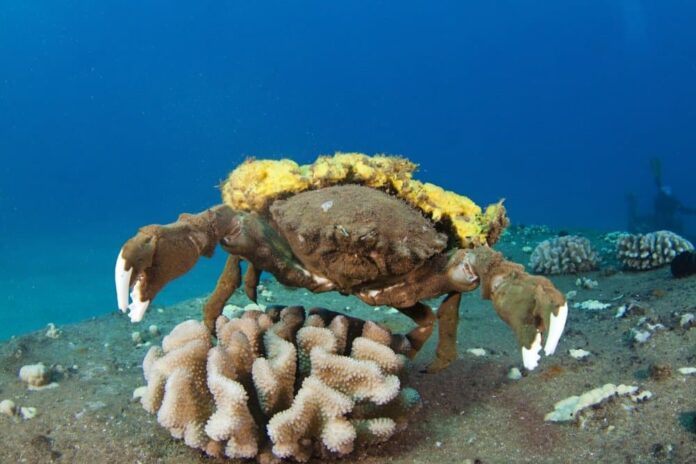
Scientific Name: Dromia dormia
Here we have the largest species of sponge crab that is also one of the poisonous crab species. The sleepy sponge crab can grow up to 20 centimeters in carapace size which it uses to carry a sponge. And this is also how it earns its name. A sleepy sponge crab cuts a sponge with its claws, and then holds the sponge in place with its hind legs. Besides sponges, some sponge crabs also carry other items like a coconut husk, hollow pieces of wood, and more. They use those pieces to disguise themselves to avoid predators from spotting them.
These crabs have a widespread distribution in the Indo-Pacific region with a range from East Africa to Australia and more. Normally, they live in shallow waters at a depth of 112 meters deep at most. During the day, they hide in caves and cracks as they only come out at night. These crabs scavenge dead animals and dead plants as well as other animals that they can find.
The crabs themselves are not poisonous but the sponge that they pick to carry with them is. Those who are not careful might not remove the sponge properly which can be poisonous and toxic to consume. This is why it is not advisable to eat sponge crabs as most species are toxic.
Related Post: Poisonous Birds You Should Not Eat

